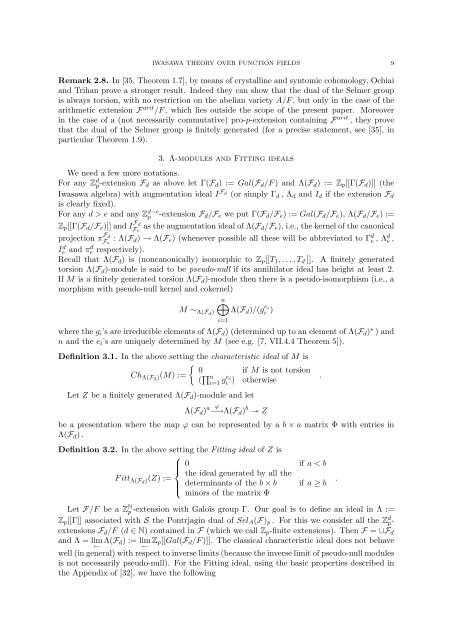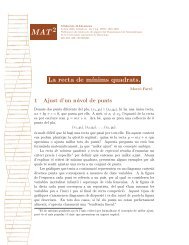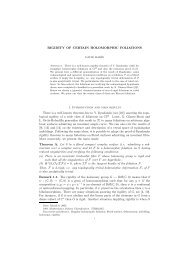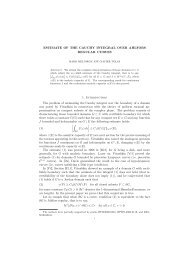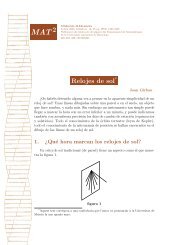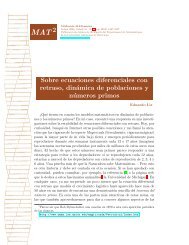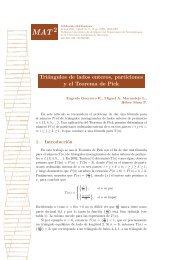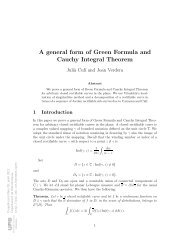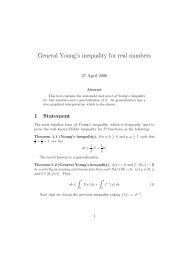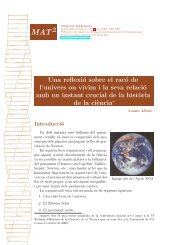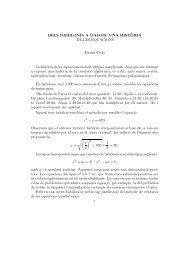ASPECTS OF IWASAWA THEORY OVER FUNCTION FIELDS 1 ...
ASPECTS OF IWASAWA THEORY OVER FUNCTION FIELDS 1 ...
ASPECTS OF IWASAWA THEORY OVER FUNCTION FIELDS 1 ...
Create successful ePaper yourself
Turn your PDF publications into a flip-book with our unique Google optimized e-Paper software.
<strong>IWASAWA</strong> <strong>THEORY</strong> <strong>OVER</strong> <strong>FUNCTION</strong> <strong>FIELDS</strong> 9Remark 2.8. In [35, Theorem 1.7], by means of crystalline and syntomic cohomology, Ochiaiand Trihan prove a stronger result. Indeed they can show that the dual of the Selmer groupis always torsion, with no restriction on the abelian variety A/F , but only in the case of thearithmetic extension F arit /F , which lies outside the scope of the present paper. Moreoverin the case of a (not necessarily commutative) pro-p-extension containing F arit , they provethat the dual of the Selmer group is finitely generated (for a precise statement, see [35], inparticular Theorem 1.9).3. Λ-modules and Fitting idealsWe need a few more notations.For any Z d p-extension F d as above let Γ(F d ) := Gal(F d /F ) and Λ(F d ) := Z p [[Γ(F d )]] (theIwasawa algebra) with augmentation ideal I F d(or simply Γ d , Λ d and I d if the extension F dis clearly fixed).For any d > e and any Z d−ep -extension F d /F e we put Γ(F d /F e ) := Gal(F d /F e ), Λ(F d /F e ) :=Z p [[Γ(F d /F e )]] and I F dF eas the augmentation ideal of Λ(F d /F e ), i.e., the kernel of the canonicalprojection π F dF e: Λ(F d ) → Λ(F e ) (whenever possible all these will be abbreviated to Γ d e , Λ d e ,Ie d and πe d respectively).Recall that Λ(F d ) is (noncanonically) isomorphic to Z p [[T 1 , . . . , T d ]]. A finitely generatedtorsion Λ(F d )-module is said to be pseudo-null if its annihilator ideal has height at least 2.If M is a finitely generated torsion Λ(F d )-module then there is a pseudo-isomorphism (i.e., amorphism with pseudo-null kernel and cokernel)M ∼ Λ(Fd )n⊕i=1Λ(F d )/(g e ii )where the g i ’s are irreducible elements of Λ(F d ) (determined up to an element of Λ(F d ) ∗ ) andn and the e i ’s are uniquely determined by M (see e.g. [7, VII.4.4 Theorem 5]).Definition 3.1. In the above setting the characteristic ideal of M is{0 if M is not torsionCh Λ(Fd )(M) :=( ∏ ni=1 ge ii ) otherwise .Let Z be a finitely generated Λ(F d )-module and letϕΛ(F d ) a −→Λ(F d ) b ↠ Zbe a presentation where the map ϕ can be represented by a b × a matrix Φ with entries inΛ(F d ) .Definition 3.2. In the above setting the Fitting ideal of Z is⎧0 if a < b⎪⎨the ideal generated by all theF itt Λ(Fd )(Z) :=determinants of the b × b if a ≥ b⎪⎩minors of the matrix ΦLet F/F be a Z N p -extension with Galois group Γ. Our goal is to define an ideal in Λ :=Z p [[Γ]] associated with S the Pontrjagin dual of Sel A (F) p . For this we consider all the Z d p-extensions F d /F (d ∈ N) contained in F (which we call Z p -finite extensions). Then F = ∪F dand Λ = lim←Λ(F d ) := lim←Z p [[Gal(F d /F )]]. The classical characteristic ideal does not behavewell (in general) with respect to inverse limits (because the inverse limit of pseudo-null modulesis not necessarily pseudo-null). For the Fitting ideal, using the basic properties described inthe Appendix of [32], we have the following.


